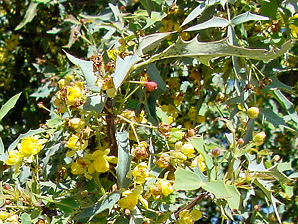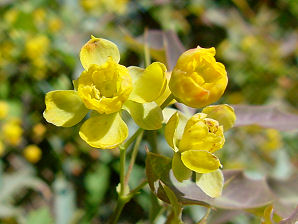Arizona Wild Flowers
Pictures, Photos, Images
Descriptions, Information, Reviews.
Red Barberry, Mahonia haematocarpa or Berberis haematocarpa.
We Are Proud Of Our SafeSurf Rating!
Click On Any Of The Following Links By Amazon.Com
For Books, & Videos About Wildflowers Of Arizona & The Southwest USA. No Obligation!
| Red Barberry, Mahonia haematocarpa. |
|---|
 |  |
| Red Barberry, Mahonia haematocarpa. | Red Barberry, Mahonia haematocarpa. |
|---|
 /
/

Red Barberry.
We wish to thank Wikipedia, the free encyclopedia for some of the information on this page. We share images and information with Wikipedia. Mahonia haematocarpa is a species of barberry known by the common name red barberry. It is also sometimes called algerita, but that name is more often applied to its relative, Mahonia trifoliolata. It is native to the southwestern United States and northern Mexico, where it grows in desert chaparral and woodlands, such as in the Mojave Desert of California. This is an erect, dicot, upright, spreading shrub, reaching up to about 12 feet and almost as wide. The leaves are several centimeters long and are each made up of a few thick, waxy, lance-shaped leaflets with spiny toothed edges. The inflorescences bear 3 to 5 bright yellow flowers, each with nine sepals and six petals all arranged in whorls of three. The fruit is a juicy, edible yellow-orange, pink, or usually redi berry just under 3/8 inches wide.
Quick Notes:
Height: Perennial, evergreen growing to about 12 feet tall & 12 feet wide.
Trunk: Up To About 8 inches to 1 Foot Thick.
Flowers: Small clusters of fragrant yellow flowers borne in upright, clusters of 3 to 7 flowers. Monoecious; perfect, about 1/2 inch in diameter.
Flowering Time: Mid February - April.
Fruit: Edible, tart, yellow-orange, pink, or red berrys in mid-summer, which make good jelly and wine.
Leaves: Alternate, pinnately compound, evergreen, 3 to 5 inches long; 3 to 5, narrow, long holly-like leaflets each 2 to 3 inches long, sharply spined teeth, thick, waxy, gray to blue-green above and paler green below.
Found: The USDA claims Red Barberry is native of the USA (AZ, CA, CO, NM, NV, TX). In Arizona it is native to all counties, except Navajo, & Apache. Also northern Mexico in Sonora.
Hardiness:
Soil pH requirements:
Sun Exposure:
Elevation: 3,000 - 7,000 Feet. Usually below 4,000 feet.
Habitat: Any well draining soil, from the Pecos River, West into Arizona.
Miscellaneous: Flowering Photos Taken March 10, 2005.
|



We Are Proud Of Our SafeSurf Rating!
Click On Any Of The Following Links By Amazon.Com
For Books, & Videos About Xerioscape Plants Of Arizona & The Southwest USA. No Obligation!
Back To Arizona Wild Flowers Home Page.
Back To Arizona Wild Flowers; Yellow Flowers Page Two.
Back To Arizona Xeriscape Landscaping Main Page.
Back To Xeriscape Shrubs Page Three.
Back To DeLange Home Page
© 1966 - Present, Audrey, Eve, & George DeLange
| © 1966 - Present, Audrey, Eve, & George DeLange |


